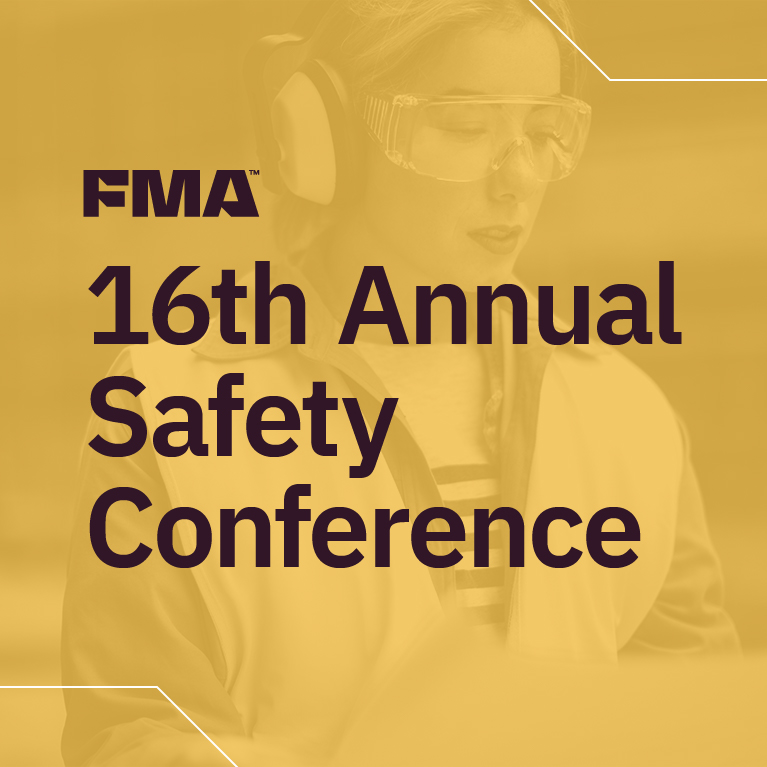Zero Landfill Underscores Zero-VOC Achievement
By Kate Bachman | July 20, 2012
Category:

Brenda Demaree, Portland Purdy site’s sustainability and facility manager, headed up the site’s zero-landfill initiative. The manufacturer makes more than 200 different types of paintbrushes and other painting tools such as paint rollers. Every hand-crafted Purdy paintbrush bears the initials of the employee who made it.
Sherwin-Williams®, a 146-year-old, $8.8-billion-annual-sales paint and associated products company, is the largest U.S. producer of architectural coatings (house paint) by revenue. It has 72 plants and distribution facilities, 100 blending stations, 3,400 stores, and 35,000 employees.
A company doesn’t grow that successfully without having a sustainable business strategy. For Sherwin-Williams, that includes having a sustainability plan.
- Read how Purdy achieved zero landfill
- Find out how a Purdy paintbrush is made
- Discover how the site refused to be painted into a corner
Some of the manufacturer’s paint products were converted from solvent-based to zero-VOC as long as eight years ago. “Our low-VOC [formulations] started with Healthspec in the ’90s. ‘Low’ used to be considered 50 grams of VOC per liter. Now it’s even lower,” said Sherwin-Williams Director of Environmental Affairs Scott Thomas.
“We’ve continued to make strides so that there actually are no grams per liter of measurable amounts in our VOC-free products. By eliminating VOCs, you eliminate external air pollution, but you also help with indoor air quality and odor.
“We’ve been a leader in that area,” he said.
So, if you’re one of the world’s largest paint manufacturers and you’ve already succeeded in formulating zero-VOC paint, what’s the next step on your sustainability journey?
You move on to zero landfill waste.
Sustainability Goals
Sherwin-Williams always practiced waste minimization and energy conservation, but just formalized its “sustainability journey” about five years ago, Thomas said. “We started to collect environmental data on the amount of energy we were consuming, the amount of raw materials we were consuming, and the waste we were creating. We developed a database in-house we call EcoMet, and we asked that all the core supply chain facilities, and a few of the larger blending facilities, begin to report these metrics globally.”
The company set five strategic performance goals for the supply chain globally, which are normalized based upon production. Three of the five goals involve reducing waste: nonhazardous liquids by 25 percent per hundred pounds filled; nonhazardous solids by 25 percent; and hazardous waste by 50 percent.
Purdy Becomes First Zero-Landfill Sherwin-Williams Facility
Paint and Coatings Division President Joel Baxter challenged the corporation’s paintbrush plant in Portland, Ore., to be the first facility to achieve 100 percent zero waste to landfill.
Purdy Professional Painting Tools was founded in 1925 by S. Desmond Purdy in his converted two-car garage in Oregon and acquired by the Sherwin-Williams Co. in 2004. The paintbrush products, hand-crafted in the U.S., are considered among the best by professionals. Independent research by Frost & Sullivan indicated that by a 3-to-1 margin, U.S. paint contractors named Purdy’s paintbrush best overall. The research also showed 100 percent overall satisfaction. The manufacturer makes paint rollers and other paint supplies as well.
Purdy Plant Manager Jeff Eichelberger relayed how his team received the challenge. “Joel [Baxter] called us up and said, ‘I want you guys to be the first site to be zero landfill. Can you do it?’ He came up and spoke to our employees and issued the challenge directly to them,” Eichelberger said.
Purdy had won the Sherwin-Williams Corporate Sustainability Award in 2008. “So he knew that we had the right formula to make this happen first,” said Brenda Demaree, Purdy’s sustainability and facility manager. Demaree is the plant’s go-to person for any sustainability questions that arise.
Purdy readily grasped the challenge. The paintbrush-maker had been sending 250,000 lbs. (125 tons) of waste to landfill a year. Now it sends zero. “We had our last trash compactor pickup in November 2009,” Demaree said.
The achievement helped Purdy win yet another trophy just last April. The city of Portland recognized the manufacturer for its outstanding sustainability achievements with the BEST Award for business leadership in environmental, economic, and social sustainability. Purdy also won the Corporate Site of the Year Award in 2007 and 2010—the first two-time winner at Sherwin-Williams.
How Purdy Got to Zero
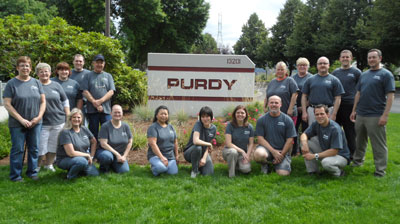
Figure 1
The Green Team comprises employees from different areas of the plant.
To reach these goals, the site formed a Green Team—a committee of people representing different parts of the plant and from each shift, Demaree said (see Figure 1). “So we started out with a small group of people who were excited to take on the challenge and wanted to make a difference.” The Green Machine began identifying and quantifying waste streams in the plant.
“We’ve recycled for the past 25 years at this facility,” Eichelberger said. “We’ve had specialized Dumpsters for cardboard, wood, and metal. When we received that challenge, we thought, well, let’s take a look at what’s going into our compactor.”
“We went out and took a Dumpster dive in the back [see Figure 2]. We couldn’t believe what we found,” Demaree said. “It was a lot of cardboard, pop cans, plastic bottles, and stuff that could be easily recycled, so the first thing that we thought of was, hey, let’s make our employees aware of recycling things that are obviously recyclable.”
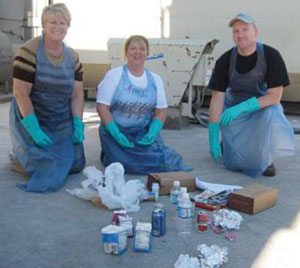
Figure 2
The zero-landfill journey began with a Dumpster dive to assess the waste streams.
Training Employees. Educating the site’s employees as to what is recyclable and how to sort the materials into color-coded, segregated bins was the first and most effective step (see “Figure 3 )
“So when you teach employees about recycling, you start seeing cardboard going to the right place, and you reduce your cardboard going to the landfill,” Eichelberger said. “And then once we got through the obvious items, we had to look at the tougher items to find outlets for.”
“And along the way, we celebrated Earth Day and provided a lot of facts about pollution and how it affects the environment; information about how to recycle and compost at home,” Demaree said. “We put up posters showing what compost is and how it is made into fertilizer. So we just made sure they knew where the composter is and what goes into it.”
“One of the keys to achieving what we did at this facility was employee engagement,” Eichelberger added. “If it weren’t for our employees being engaged, we wouldn’t have been able to pull this off. They are taking it upon themselves to sort materials into recycling containers at their workstations.
“We didn’t go to every employee and say, ‘We’re going to go zero landfill, now everyone go out and do it.’ We wanted to take a different approach. We relayed information and created understanding of that information, which creates belief, which then in turn generates commitment. And that commitment turns into action,” Eichelberger said.
“Then when you say, ‘Let’s go zero landfill,’ they’ve got information, they’ve got passion, which creates a motivated and committed workforce. So we spend a lot of time teaching.”
Recycling. Demaree and the Green Team follow up with their recyclers and have toured their facilities as part of doing due diligence. “We needed to verify that it was cradle-to-cradle; that when we pay a certain recycler to take things, we want to make sure they’re doing it. We want to make sure that they have a good process for recycling so we can be sure that they’re not sending it to the landfills,” Demaree said.
So we built relationships, we toured the recycling centers, the local materials recovery facility, Port of Portland, the airport … We’ve gained information about how to really get better at doing the right thing,” she said. Symbiotically, one of the resources Purdy accessed was an article on zero landfill published in the Sept./Oct. 2010 issue of Green Manufacturer, she said.

Figure 5
Maggie Cha, a Purdy employee, weaves baskets out of nylon strapping scrap.
Reusing Components, Packaging. Demaree and the team looked at some of the materials used in their processes to see what could be reused. The first place Demaree looked for reuse opportunities was the suppliers (see Figure 4). Several suggestions for strategies for reusing materials came directly from employees on the plant floor. In some instances, Demaree and the team have to tap their creativity to find outlets. They began tracking each waste stream and found green outlets for them.
One of Purdy’s employees weaves baskets out of nylon strapping scrap (see Figure 5).
“One supplier uses polystyrene foam inserts in their boxes. We send them back and they reuse them,” Demaree said. “Another supplier puts little clips on the rolls. We save those clips and send them back and they’ll reuse them.” Other items that are returned to suppliers are plastic reels that hold labels and oil-absorbing paper inserts.
The facility saves all of its cardboard boxes to recycle as cardboard or for reuse (see Figure 6).”We stack them up, band them, and then send them to one of our corporate Sherwin-Williams distribution centers,” Eichelberger said. “Whenever we’re sending product there, we see if there’s room in the truck for a pallet, and we stick a pallet of boxes in there.
“They use them instead of buying new boxes. It saves them a little bit of money,” he added.
The manufacturer also makes paint rollers. The roller core is formed of polypropylene on a machine on-site, and then employees bond different types of woven and knitted fabrics to the core. It is finished and trimmed, which generates lint scrap.
The polypropylene scrap is sent to a plastics recycler.
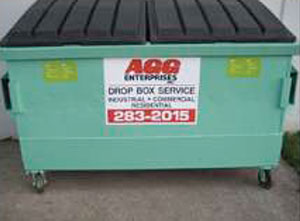
Figure 7
A green compost bin, which sits just outside the cafeteria, is picked up with the recyclables regularly.
“I’m doing a lot of reuse of lint,” Demaree said. “A lot of our employees are using it for stuffing in their sewing projects at home. Some of it goes to a store called Scrap. If you Google it, you can see the interesting things they do with it, like for school supplies.”
Composting. Demaree located various agencies to contact on how to pool resources. In doing so, she discovered that compost pickup was available. The city of Portland collects compostables—food waste, paper containers, and yard waste. “So we initiated a composting program. That eliminated another 6 tons of waste,” she said (see Figure 7).
“We love having the compost pickup. It makes composting really quite easy for us,” Demaree said. “We just have a green Dumpster outside of our cafeteria. The employees separate the compost and put it in green compost bags and the waste hauler collects it and brings it to a composting center. Then people can go there to pick up compost for their gardens and farms.”
Down to Rubber Bands …
After getting full participation from employees in recycling all of the standard recyclables and reusing several other materials, Demaree sought outlets for two byproducts unique to the manufacturer’s process—rubber bands and filament scrap.
Now several boxes of rubber bands are stacked by the front door of the building. Visitors are urged to take some with them when they leave. “Free to a good home.”
“When we take the filament [bristle material] out of the box to make a paintbrush, it is wrapped in rubber bands. And often we have to put a second rubber band on the filament to fit it into the machine. In doing that, we accumulate 40 lbs. of rubber bands a day. So that’s another challenge for us,” Demaree said.
She first contacted her filament supplier, but its process does not accommodate finished and used rubber bands. She has given boxes of rubber bands to local schools, libraries, churches, even a local tulip farmer.
But the outlet stream is a little spotty. “We still have a challenge because we’ll find a source, but it’s not sustainable. We’ll give them some and it lasts them a year and then they don’t want any more rubber bands from us,” she said.
… and Filament
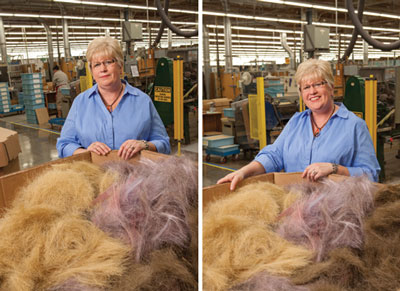
Figure 8
When Purdy’s outlet for filament scrap could no longer accept it, the paintbrush-maker’s zero-landfill status was at risk until Demaree found another outlet six months later. Until then, though, the boxes of filament stacked up.
One of the last byproducts the team had to find an outlet for was filament scrap. In the paintbrush manufacturing process, a small percentage of the filament lands on the floor, Demaree explained. It’s nylon, or a nylon/polyester blend, 2 to 41⁄2 inches long (see Figure 8). “We used to just sweep it up, put it in the compactor, and send it to the landfill. So we started saving
it, and looked for opportunities to find an outlet for it.”
“First, we worked with our corporate purchasing group to see if they had any ideas,” Eichelberger said. The group provided contact information for companies in similar industries that might be able to use the byproduct filament. Demaree just started making cold calls to some of the companies.
Next, Demaree asked the filament supplier, DuPont, for help finding outlets, and DuPont set them up with a recycler. “That company really helped us out,” she said. “They gave us a baler and set us up with a program. We did that for about a year and a half. And then their process hit a roadblock, because it wasn’t efficient at separating the nylon from the polyester. So we lost that recycler,”
she said.
Once the Purdy site achieved zero landfill, it didn’t want to lose that status. “It was a challenge because we were zero landfill for a year and a half. We asked ourselves, What were we going to do with it? It piled up for six months,” Eichelberger said.
Demaree and Eichelberger refused to be painted into a corner. The team found a company that could use the nylon/polyester filament in its filler material. “They actually prefer it loose, rather than baled. So we put it in gaylord boxes that the paint roller components come in and we fill the boxes back up with filament,” Demaree said. “We send it by rail, and they pay for the freight. It saves us from having to bale it, it saves them resources that more than pay the cost for the freight, and we divert it from the landfill.
“Working with people and sharing this type of information can be really beneficial, because one company’s waste is another company’s resource,” she added.
Waste to Energy. Some items, such as cigarette butts, latex gloves, spent air filters, and disposable earplugs, that are accumulating in a compactor on the lot will be sent to a waste-to-energy process when the compactor is full. The site recently began fitting its employees with formed, reusable, individualized earplugs, which will reduce the amount of disposable earplug
waste it generates.
Freecyling. For odd items that no longer can be used in the plant but that are still usable, such as tables, work-benches, and filing cabinets, the facility has set up a “Free Table.” Employees can take these items home. “We’ll put things on the table in the morning and they’re gone by noon,” Demaree said.
Spatter of Influence
Schools. The Purdy team reached out to its local school, allowing students to tour the facility and mentoring them in their waste management program called STARS (Students and Teachers Achieving Recycling Success), Eichelberger said. It is especially significant to him because his own children attend school there. “Now they’ve made it a challenge to be a zero-landfill school. So we’re really excited to be working with them.”
“They’re getting awards now,” Demaree said. She was asked to speak at an awards ceremony where they received an Oregon Green School Award.
Other Manufacturers. As the pilot zero-landfill facility, Purdy now practice-shares with all of the other Sherwin-Williams manufacturing and distribution facilities seeking to achieve zero landfill. The Purdy site has hosted tours and seminars for representatives from other Sherwin-Williams manufacturing facilities, including paint manufacturers across the country. “We are proud to help them with their journey to zero landfill, because this is a companywide initiative. Our goal is to help everyone become zero landfill. A lot of other sites are at 97 percent landfill diversion,” Eichelberger said.
In addition, Purdy recently hosted a Green Manufacturer Network “Take on the Zero-Waste-to-Landfill Challenge” workshop, which included letting other manufacturers tour the facility and hear a presentation about how it achieved zero landfill.
Food Banks. Demaree said the site donates six pallets of cardboard boxes to the local food bank for packaging food every Monday. “It saves them a lot of money. I just got a call the other day from the food bank just to thank me,” Demaree said.
Zero Landfill Blends With Corporate Sustainability Goals
Community. Now that the employees have embraced sustainability in their plant, that spirit has extended to the community at large. Employees participate in cleaning up nearby Smith and Bybee Lakes; painting a local school; beautifying an “adopted” road; and volunteering at the local food bank.
The zero-landfill achievement is prominently featured in Sherwin–Williams’ sustainability report, which it publishes on its website, Thomas said. “There are a number of drivers and they’re the logical ones. First, we’re able to tell our story in what we have accomplished.
“Publishing the report helps with morale, and also with recruitment,” he continued. “We’re always trying to recruit bright young people. Sustainability helps with bringing them onboard. In communities, with customers, and with people we’re trying to attract, there is an increasing appetite for sustainability.
“One of my roles is to respond to surveys from customers that have expectations from companies such as ours as an entrée to sales. What are we committed to? What are we doing? And I see that increasing.
“I think there’s an increasing appetite from consumers to have products that are more environmentally friendly or favorable, so the products we’re developing now with zero VOCs are hitting their mark.
“In addition, it really does help the bottom line. You can see where you remove waste and eliminate that cost—maybe even make it an income stream—and it goes straight to the bottom line.”
Like all companies selling into the home improvement market, the drop in home sales that occurred after the real estate bubble burst, coupled with a strong headwind in the economy, put Sherwin-Williams in a very difficult position, Thomas said. “So you’re tightening your belt, you’re making tough business decisions—anything you can do that makes the operations more profitable or lean—and these
things clearly do.
“Every dollar in waste that you save helps,” Thomas said. “You don’t have to sell another gallon of paint in order to achieve it. So there’s a strong business component to it as well.”
Purdy’s Perspective
Eichelberger added his perspective. “I have a lot of respect for the people who are leading our company. Our guiding values are integrity, service, quality, people, performance, innovation, growth. It’s the right thing to do. I think the question is, Why wouldn’t we want to do something like this?
“We’re constantly challenging ourselves to get better,” Eichelberger continued. “Being zero landfill is great, but then we look at our recycling rate and ask, Now what can we reuse? Recycling is a good first step, but we’re still putting a lot of good resources into recycling that we could be reusing.”
Oh, and if you have a use or need for nylon/polyester filament or rubber bands, Demaree and Eichelberger would love to hear from you.
Making a Purdy Paintbrush

The paintbrush-making process starts when the filaments of different lengths and sometimes different materials—polyester and nylon—are mixed in a special machine built just for that purpose.
A brushmaker expertly readies the filaments to become the paint-holding bristles of the brush, then inserts them into a copper or stainless steel ferrule. The brushmaker carefully combs the brush bristles—nylon filaments, nylon/polyester filaments, or natural hog hair—to ensure that they are all straight. Any metal scrap generated is profitably recycled.
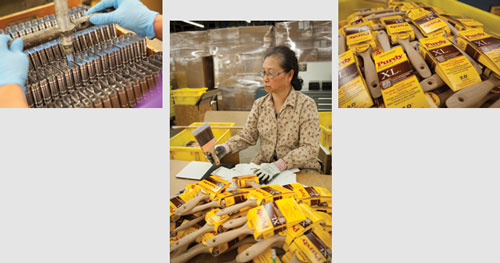
Epoxy is inserted into the stainless steel or copper ferrules to secure the bristles in the brush heads.
No Purdy paintbrush goes out the door unless it passes inspection by the scrutinizing and discriminating eyes of Khanty Sihapanya.
All of the paintbrush handles are constructed from western red alder wood, Eichelberger said. “That’s the material Desmond Purdy picked back in the day, when he founded the company in 1925. The story goes that it was good wood for paintbrushes because it’s lightweight, has good balance, and feels good in the palm of your hand. It’s a readily available resource here in the Northwest.”
When completed, the brushes are placed into reusable paperboard keepers.
Sherwin-Williams Purdy site is located at 13201 N. Lombard St., Portland, OR 97203, 503-595-1325, brenda.j.demaree@sherwin.com, www.sherwin-williams.com.
Sherwin-Williams, 101 Prospect Ave., Cleveland, OH 44115, 216-566-2000, www.sherwin-williams.com.

Side by side, we move metal fabrication forward.
FMA unites thousands of metal fabrication and manufacturing professionals around a common purpose: to shape the future of our industry, and in turn shape the world.
Learn More About FMA